World Malaria Day 2023 – zeroing in on malaria
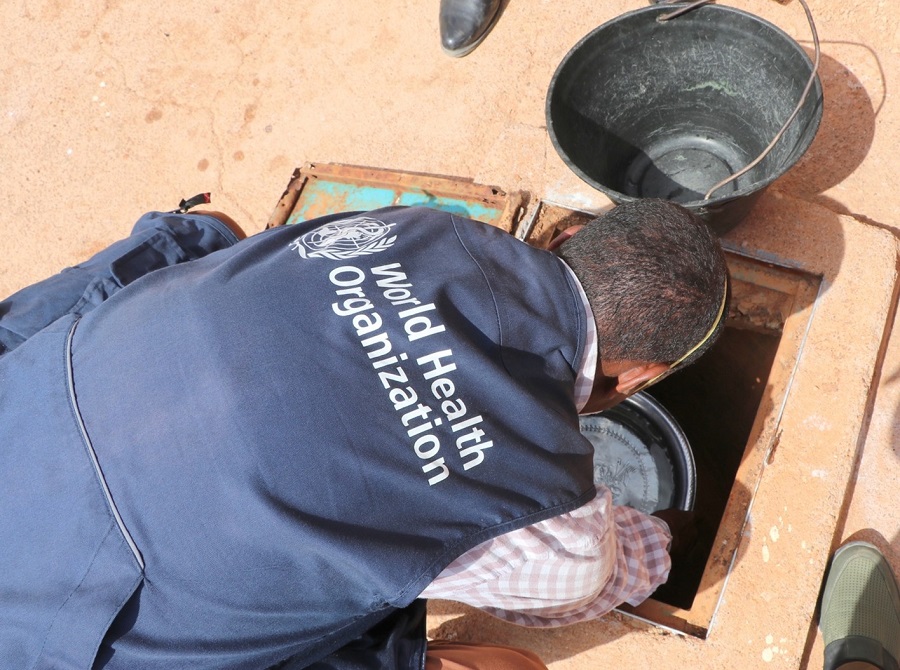 A WHO staff member inspecting a small water tank to identify and control mosquito breeding sites. Credit: WHO
A WHO staff member inspecting a small water tank to identify and control mosquito breeding sites. Credit: WHO
Mogadishu 25 April 2023 – The Federal Ministry of Health, together with the World Health Organization (WHO) Somalia, commemorates World Malaria Day on 25 April to reflect on the progress made in the fight to eliminate malaria. Malaria continues to pose a significant threat to the health and well-being of millions of people globally, particularly in sub-Saharan Africa, where most malaria cases and deaths occur. On this year's World Malaria Day, WHO emphasizes the importance of implementing strategies and reaching marginalized populations in the fight against malaria. As part of this year’s theme "Time to deliver zero malaria: invest, innovate, implement" campaign, WHO highlights the critical need to provide access to diagnostics, treatment and care for those who need them most.
Significant progress has been made in malaria control in Somalia, with substantial decreases in transmission since 2019, thanks to scaled up interventions. Additionally, the impact of the drought in Somalia has contributed to reducing malaria transmission across the country, including in previously high and moderate transmission areas along the Shabelle and Jubba Rivers. Despite a high risk of epidemics in northern regions, malaria infections in the community remain low and much of the country is suitable for elimination efforts.
Throughout Somalia, the malaria species Plasmodium falciparum has been the predominant cause of infection, accounting for over 92% of cases. This poses a complex situation due to the severity of malignant malaria. Furthermore, the invasive mosquito species Anopheles stephensi, capable of transmitting both P. falciparum and P. vivax malaria parasites, was detected in 6 locations in Somalia between 2020 and 2021. Unlike other major mosquito vectors of malaria, Anopheles stephensi thrives in urban environments, making vector control a top priority for the malaria programme.
On the road to zero malaria
The WHO Country Office, in collaboration with other stakeholders, mainly UNICEF, with support from the Global Fund to Fight AIDS, Tuberculosis and Malaria, provides support to the health authorities in efforts to tackle malaria transmission in the country. These include indoor residual spraying (IRS), distribution of long-lasting insecticidal nets (LLINs), larval source management, and malaria case management. WHO also supports the Government in strengthening surveillance and entomological monitoring efforts in the country, as well as monitoring insecticide susceptibility and drug efficacy on malaria parasites.
Dr Jamal Ghilan Amran, the Malaria Focal Point for WHO Somalia, emphasised the significance of adopting an integrated approach to prevent malaria. He stated, "Malaria prevention and surveillance are crucial elements of malaria elimination, mainly in the northern and central regions. Without efficient and coordinated prevention measures, coupled with robust surveillance, monitoring, and timely response to transmission pattern changes, we risk forfeiting the progress we have made in combating malaria."
In Somalia, malaria is endemic across the country, particularly in the south and central parts of the country. However, the country has decided that conditions were right to target 6 districts for elimination as a pilot project – Odweyne in the region of Togdher; Ainabo in Sool; Burao in Togdher; Sheikh in Sahil; Burtinle in Nugal; and Goldogob in Mudug – all in Somaliland and Puntland. Planning for other regions would have been a challenge, mainly due to insecurity. As a result, from May 2021 onwards, led by the Somali Government and supported by the Global Fund, WHO and UNICEF are rolling out national malaria elimination programmes in these 6 districts towards reaching the zero malaria target.
In 2022, 336 840 suspected malaria cases were tested, of which 11 550 were positive. Compared with 2021 and 2020, the positive cases declined by 11% and 61%, respectively. A total of 2 malaria-related deaths were also reported in 2022. All these cases were treated with artemisinin-based combination therapy as per the national treatment guidelines.
Similarly, in 2021 and 2022, WHO provided technical support to implement IRS interventions in Mogadishu, Qardo, and parts of Puntland and Somaliland. The intervention exceeded the initial target, with 85 837 households sprayed. Between June 2022 and March 2023, the LLINs mass campaign, supported by UNICEF, distributed almost 2.9 million bednets in 31 selected districts, including over 1.4 million LLINs distributed to internally displaced persons. Prior to the campaign, there was an extensive engagement between sub-recipients, the national malaria control programme, WHO, and UNICEF. This involved quantification and detailed microplanning. Additionally, the national LLIN distribution guidelines were updated to provide essential guidance to the government and distribution partners.
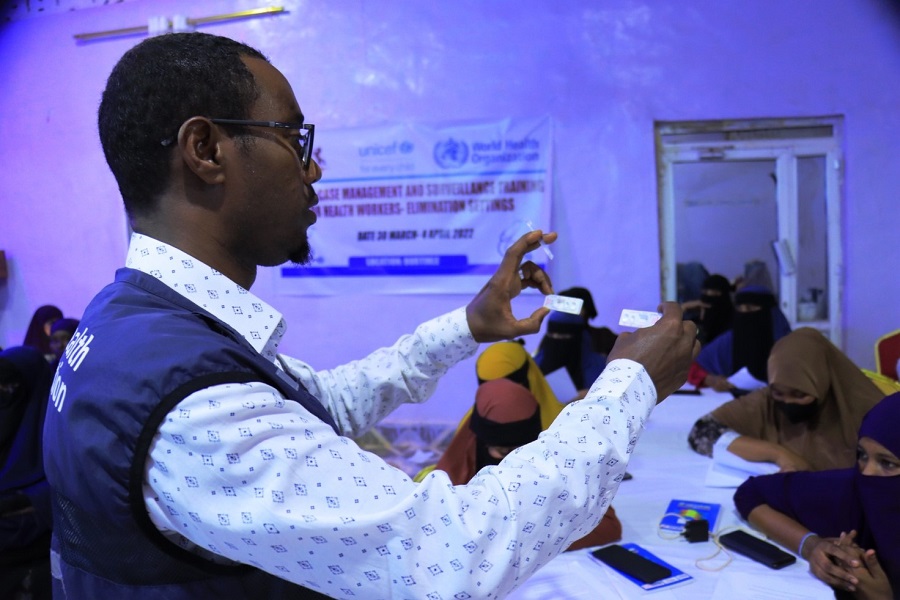 WHO conducts malaria case management and surveillance training for health workers 30 March–4 April 2022, Burtinle, Puntland. Credit: WHO
WHO conducts malaria case management and surveillance training for health workers 30 March–4 April 2022, Burtinle, Puntland. Credit: WHO
Further, entomological monitoring and surveillance have been enhanced through the reinforcement of sentinel sites and improved insecticide resistance monitoring, which aligns with the 2019 insecticide resistance monitoring plan that is currently being updated. Vector control has been incorporated into primary health care, and there is an emphasis on the collection of comprehensive entomological surveillance data. These data are used to identify malaria vectors, including Anopheles stephensi, and to monitor the spread, geographical and temporal distribution, and density of these mosquitoes, as well as their feeding and resting behaviours.
Although Somalia has made significant progress in controlling and eliminating malaria, much work remains to be done. This includes raising awareness about malaria prevention, community and private sector involvement, enhancing cross-border collaboration to prevent the importation of vectors and parasites, and ultimately achieving the goal of zero malaria-related deaths.
Global burden of malaria
According to the latest World Malaria Report 2022, from 2000 to 2015, the number of malaria cases decreased steadily; however, since 2016, malaria cases have been increasing. The most considerable increase was observed during the first year of the COVID-19 pandemic, between 2019 and 2020, with a rise of 13 million cases. In 2021, an estimated 247 million malaria cases and 619 000 deaths were reported. The WHO African Region bears the brunt of this burden, with 95% of malaria cases and 96% of deaths occurring in the Region. Children under 5 years old account for 80% of all malaria deaths in the Region.
The WHO Global Technical Strategy for Malaria 2016–2030 aims to reduce malaria incidence and mortality rates by at least 90% by 2030, eliminate malaria in at least 35 countries, and prevent a resurgence of malaria in all malaria-free countries.
------------------
For additional information, please contact:
Kyle DeFreitas
External Relations Officer
Fouzia Bano
Communications Officer
Related links
/somalia/news/at-risk-zero-dose-children-get-vaccines-as-somalia-drought-woes-mount.html
https://www.who.int/teams/global-malaria-programme/reports/world-malaria-report-2022
World Immunization Week 2023: Somalia resolves to work on “The Big Catch-Up”
 Vaccinators continue to save children from vaccine preventable diseases across Somalia. Credit: WHO/Somalia
Vaccinators continue to save children from vaccine preventable diseases across Somalia. Credit: WHO/Somalia
Mogadishu, 24 April 2023 – The Federal Ministry of Health, in collaboration with the World Health Organization (WHO) and the United Nations Children’s Fund (UNICEF), observed World Immunization Week under the global theme of “The Big Catch-Up” with a resolve to strengthen primary health care and routine immunization across the country and ensure that no one is left behind.
World Immunization Week 2023 is being observed during the global COVID-19 pandemic and hence it has been given the theme of ‘The Big Catch-Up’. World Immunization Week was initially endorsed in May 2012 by the World Health Assembly (WHO's decision-making body) and the first World Immunization Week was observed the same year across 180 Member States of WHO.
The Federal Minister for Health Dr Ali Haji, on this occasion expressed gratitude to WHO and UNICEF for coordinating and collaborating with multiple partners and helping his government to catch up on lost progress in essential immunization, as a result of the global pandemic. Acknowledging the worst ever drought gripping the country, resulting in huge population displacement and outbreaks of diseases, Dr Haji hoped that “in line with the theme of the year -“The Big Catch-Up”, WHO and UNICEF would continue to support the Ministry of Health in building a strong immunization delivery system, sustain the progress made over the past few years in preventing a backslide of childhood immunization in the country and more importantly accelerate the campaign of “The Big Catch Up” to get back on track to ensure more people, particularly children, are vaccinated and protected from preventable diseases”.
As per UNICEF and WHO estimates, routi:ne immunization coverage in Somalia is low compared to other countries, and has been further impacted by the COVID-19 pandemic. The Ministry of Health, in collaboration with WHO and UNICEF, has made progress during 2022 to bridge these significant gaps in immunization by scaling up its efforts to strengthen routine immunization across the country.
WHO Representative to Somalia Dr Mamunur Rahman Malik while referring to the setbacks caused by global pandemic to routine immunization in Somalia, said that “Thousands of children under 5 have missed routine immunization during the past 3 years. The pandemic has disrupted essential immunization services in the country. We may anticipate a backslide of over 20% in routine immunization coverage unless we are able to rapidly catch up on lost progress.” He further said that, “WHO in collaboration with the Ministry of Health and UNICEF, is planning for a “Big Catch-Up” by developing an immunization recovery plan to catch up on all those children who have missed out on their routine immunization in the past 3 years, including all women of childbearing age and adults. This is our chance to restore immunization coverage to pre-pandemic levels and by working together with our partners, we can do it.”
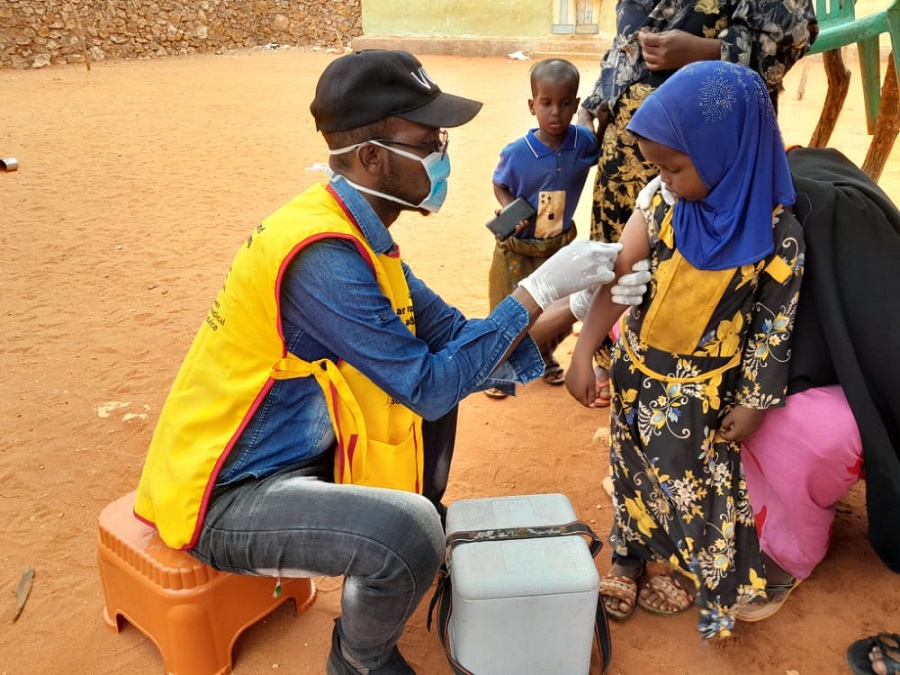 Locally recruited vaccinators are trusted members of communities across Somalia. Credit: WHO/Somalia
Locally recruited vaccinators are trusted members of communities across Somalia. Credit: WHO/Somalia
The Federal Ministry of Health, WHO and UNICEF during 2022 have jointly implemented 4 rounds of accelerated immunization activities, 5 polio campaigns, 8 campaigns for COVID-19, and nationwide integrated measles, tOPV, vitamin A and deworming campaigns. Additionally, WHO deployed more than 2100 community health workers while UNICEF has deployed over 6000 social mobilizers across the country to disseminate health messages to over 4.5 million people, as well as track and help immunize children who missed out on immunization. The community health workers have been working to find, register and refer the missed-out children and pregnant women to nearby health facilities and outreach sessions.
“UNICEF supports health systems for increasing routine immunization and integrated health and nutrition services to the children in Somalia, especially where coverage is low in hard-to-reach areas,” said UNICEF Deputy Representative, Nejmudin Kedir Bilal. “We are committed to continuing to support the Ministry of Health to generate more demand and acceptance of vaccines by the communities; to strengthen supply chain management system for vaccines and supplies; and to revamp management information system to track zero-dose children.”
The joint efforts made by the Ministry, WHO and UNICEF during the last integrated campaign helped to vaccinate more than 3.2 million children under 5 against measles and 3.5 million against polio. During 2022, immunization programmes also identified and vaccinated over 84 500 zero-dose children and vaccinated around 30 000 women of childbearing age with tetanus-diphtheria toxoids (Td2) by deploying integrated outreach teams. Somalia also managed to achieve the milestone of fully vaccinating over 41.7% of the adult population against COVID-19 in 2022.
Note to editors
Since the start of the COVID-19 pandemic in 2020, a widespread decline in childhood vaccinations has occurred globally, putting millions of additional children at risk for vaccine-preventable diseases. The continued decline in vaccination coverage since then was likely a result of many factors, including strained health systems caused by the COVID-19 pandemic, coupled with the primary focus being on the delivery of COVID-19 vaccines. These stresses have led to challenges with supply chains, human resources, and financing. Increasing vaccine misinformation, disinformation and hesitancy also likely contributed to declines in some countries. The risk of vaccine-preventable disease outbreaks is likely to persist if urgent action is not taken to recover immunization programme losses, especially in countries like Somalia, where the health sector is under immense stress of dealing with multiple outbreaks of measles, cholera and circulating vaccine-derived poliovirus 2.
-------------------------
For additional information, please contact:
Federal Republic of Somalia Ministry of Health and Human Services
UNICEF
Lisa Hill
Communications Specialist
WHO
Fouzia Bano
Communications Officer
------------------------
Related links
Expanded Programme on Immunization
State of the World’s Children 2023: For Every Child, Vaccination
WHO continues to support and invest in community-based surveillance system for COVID-19 and epidemic-prone diseases with USAID support
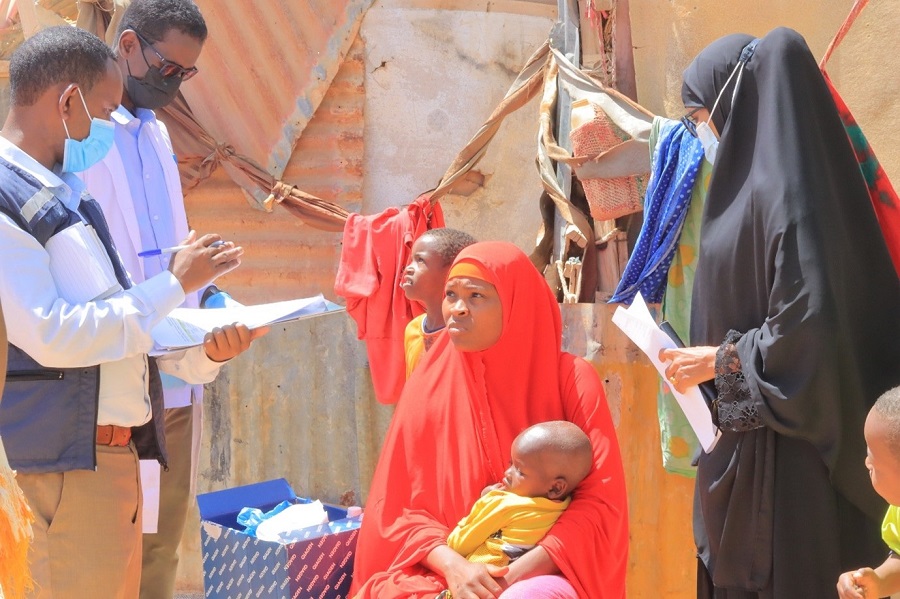
WHO-supported community health workers help connect communities with nearby health facilities to win hearts and minds of locals. Credit: WHO/Somalia
Mogadishu, 15 April 2023 – The World Health Organization (WHO) Somalia with the timely support of United Stated Agency for International Development (USAID) is helping the Ministry of Health to strengthen and expand the community-based surveillance system in underserved areas, which is essentially addressing the health system gaps and bridging a vital clog between these communities and health system.
Community health workers are being effectively used in crisis affected countries to bridge the health system gaps for surveillance when there is an acute shortage of health care workers. Learning from its successful intervention to control the community spread of COVID-19 in Somalia, WHO country office has supported the Federal Ministry of Health to deploy over 2100 community health workers (CHWs) and 237 rapid response teams (RRTs) across Somalia. With funding support from USAID, these CHWs and RRTs form the backbone of the community-based surveillance system which has been established last year to support the facility-based surveillance system of EWARN in the country for rapid detection, identification and reporting of COVID-19 cases, including other epidemic-prone diseases in the communities living in underserved and hard-to-reach areas.
“This COVID-19 plus effort by WHO is resulting in multiple benefits ranging from confidence building measures between the government and the communities, as well as in restoring our fragile health system. There, surely, was no other way to achieve these 2 milestones and I am sure that donors like USAID will continue to help us sustain such game-changing efforts,” said Dr Mukhtar Abdi Shube, National EPI Manager for Federal Ministry of Health.
These WHO-supported community health workers, almost half of whom are women, report through a mobile phone-based application for community-based surveillance. This network of CHWs was primarily established during COVID-19 pandemic to raise alerts and awareness using risk communication and community engagement activities.
However, due to prolonged drought, which has already impacted over 8.25 million people and displaced over 3.5 million across the country, WHO Somalia has helped the COVID-19 focused community-based surveillance system to graduate to a new level by including 12 epidemic prone diseases and events. After consultation with Health Cluster partners and the Federal Ministry of Health, WHO held a series of capacity-building workshops to help the existing workforce of CHWs to learn the basics of reporting on 12 prioritized diseases including COVID-19, cholera, measles, malaria, tuberculosis (TB), HIV using a syndromic-based case definition.
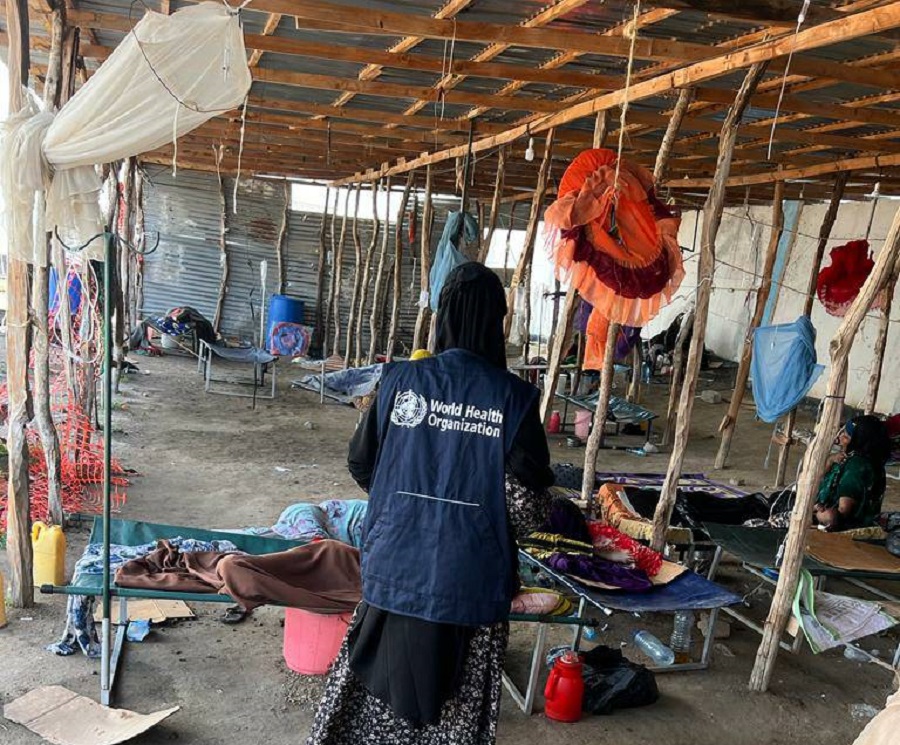 A WHO-supported cholera treatment centre in the border areas of Lower Juba region is treating patients referred by the community health workers from the neighbouring districts. Credit: WHO/Somalia
A WHO-supported cholera treatment centre in the border areas of Lower Juba region is treating patients referred by the community health workers from the neighbouring districts. Credit: WHO/Somalia
“WHO has helped us to rediscover the broken health system in Somalia by supporting us to train and deploy these front-line health workers across the country. These locally hired community health workers and vaccinators have literally helped us get in touch with the communities and for the first time we are realizing the depth and scale of the public health issues confronted by the communities,” commented Dr Bashir Ahmed, District Public Health Officer managing the cholera treatment centre in district Afmadow in Lower Juba region.
A positive by-product of this network is that it has become a functional linkage between the communities and the health system as these community health workers are referring severely malnourished children to one of 64 WHO-supported stabilization centres, serious cholera patients to one of 10 WHO-supported cholera treatment centres, pregnant women to nearby reproductive, maternal, neonatal, child and adolescent health centres or helping midwives to facilitate home-based deliveries and promoting routine immunization, as well as vaccinating zero dose children.
WHO Representative to Somalia, Dr Mamunur Rahman Malik, believes that, “These community health workers are a means to an end. They are serving as a kingpin to revive the confidence of communities in the health system, as well as helping the federal and state ministries of health to get a hand on the pulse of communities, understand their real health needs, and rapidly becoming a vital clog between the underserved communities and the fragile health system in the country.”
Community health workers across African settings have been known for extending health services at community level particularly in underserved or remote populations. The community health workers in Somalia and other humanitarian crisis-affected countries are also filling the acute human resource gaps and deliver public health services directly to underserved communities as part of outbreak and pandemic response for preventing infections and reducing spread. By virtue of their understanding of the local context in the community and trust they garner from the people they serve, the community health workers are increasingly becoming useful and effective for the response to COVID-19 and other epidemic-prone diseases.
This community-based network of health workers and rapid response teams has given the confidence to the Government to replicate it in the newly liberated areas across Somalia. In the past one year alone, these WHO-supported community health workers have visited a total of 2 029 611 households with the preventive health messaging. A total of 20 909 alerts were reported by these CHWs of which 10 174 were investigated. They screened 328 519 children for malnutrition, of whom 97 786 were referred to health facilities for necessary treatment while another 19 807 children were also referred to these health facilities due to severe respiratory issues and/or dehydration. They also provided iron and folic acid supplements to 95 524 pregnant women, while zinc and vitamin A supplements to over 145 491 children.
How the CHW network works in Somalia
WHO Somalia, together with the Federal Ministry of Health and other UN agencies, conceived an integrated health response to the drought and COVID-19 pandemic by improving access to essential health care across 48 priority districts in the country. WHO deployed these community health workers as part of this initiative to increase access to essential health care for the communities living in marginalized and underserved areas of these 48 districts.
Now, these community health workers are being trained on case detection for epidemic prone diseases beyond COVID-19, provide home-based care for children with diarrhoea, malaria, TB, HIV, and other ailments, and identify danger signs, especially among children and women, and refer them to the nearest health facility.
Since they were locally recruited and enjoyed the trust of the locals, they were also trained on delivering a range of culturally appropriate risk communication and community engagement messages on healthy living, water, sanitation and hygiene (WASH), nutrition and infant and young child feeding during house-to-house visits besides helping the state-based health authorities detect epidemics as early as possible and reduce the turnaround time for response.
To compliment the work of community health workers, WHO Somalia has also established an oversight and mentoring mechanism by deploying district-based rapid response teams. From an initial deployment of 171 teams, WHO increased the numbers to 237 teams during the pandemic. These rapid response teams include a surveillance officer, a laboratory technician, and a social mobilization officer from the districts. These teams serve to verify alerts reported by CHWs and investigate credible alerts with sample collection. RRTs are also responsible for providing supportive supervision to health facilities through the Early Warning Alert and Response Network (EWARN) system and monitor the activities of the CHWs at the household level and at various points of entry.
To meet the increased demand of the health services, WHO is maintaining the operational response capacities of 281 health facilities across the country by supporting these facilities with 64 stabilization centres, 10 cholera treatment centres, 15 oral rehydration points in Somalia. These health facilities are being supported with the provision of essential medical supplies like interagency emergency health kits, trauma kits, cholera kits, severe and acute malnutrition kits to treat children with health complications, and oxygen concentrators.
==============================
Note to editors
Since December 2021, Somalia has been experiencing an escalating drought that has affected 8.25 million people and displaced over 3.25 million people in search of humanitarian assistance. Over 6.4 million people (38% of the total population) do not have access to safe water and proper sanitation. The situation is worsened by protracted conflicts and the COVID-19 pandemic that has led to further weakening of an already under-resourced and under-staffed health system leading to a higher proportion of people with limited access to primary health care services.
At-risk ‘zero dose children’ get vaccines as Somalia drought woes mount
As drought stretches into a sixth season, WHO outreach teams target unvaccinated children reaching displacement camps where measles and pneumonia are rife.
3 April 2023 – Baidoa, Somalia – Somali farmer Fadumo Mohamed Ibrahim’s crops failed in the drought and she set out on foot for help.
Twenty-five days later, she and her daughter Khaliye stumbled into a settlement in the outskirts of Baidoa, a city in central Somalia, sick and exhausted.
“There is no health care in my village, my children have never been vaccinated,” the 30-year-old says.
 Fadumo Mohamed and her daughter Khaliye pictured at Raama Cadey camp for internally displaced people in Baidoa, Somalia, 22 March 2023. Khaliye, who has never received a vaccine, was vaccinated against measles, polio and pneumonia by an outreach team supported by WHO. Credit: Abdulkadir Zubeyr
Fadumo Mohamed and her daughter Khaliye pictured at Raama Cadey camp for internally displaced people in Baidoa, Somalia, 22 March 2023. Khaliye, who has never received a vaccine, was vaccinated against measles, polio and pneumonia by an outreach team supported by WHO. Credit: Abdulkadir Zubeyr
Arriving at the crowded settlement of fragile plastic-roofed shelters, the camp leader and health outreach workers took her to a vaccination team in an early step to safeguard their health.
“We were told by householders to get a vaccine. They told us it was important,” she adds.
 Fadumo Mohamed pictured at Raama Cadey camp for internally displaced people in Baidoa, Somalia, 22 March 2023. Credit: Abdulkadir Zubeyr
Fadumo Mohamed pictured at Raama Cadey camp for internally displaced people in Baidoa, Somalia, 22 March 2023. Credit: Abdulkadir Zubeyr
So-called ‘zero dose children’, those like Khaliye who have never received immunization of any kind, account for around half of vaccine-preventable deaths around the world.
New arrivals at Raama Cadey camp, which is home to 342 displaced families, are recorded by the camp leader Abdulkadir Abdinur Adan. He identifies their needs and reports them to a community outreach health team supported by the World Health Organization.
At a makeshift vaccination centre, with patio furniture set up in a stick-built shelter open to the elements, health workers don facemasks and rubber gloves, and vaccinate children against measles, polio, and pneumonia – often deadly diseases present in the growing settlements that ring the city.
A day after Khaliye received the shots, Fadumo hugs her tightly as she sits on the floor of a hut built at the crowded settlement, brushing off flies. “When we walked to Baidoa, the children were sick … It’s important to keep my children safe,” she says.
 Khaliye pictured at Raama Cadey camp for internally displaced people in Baidoa, Somalia, 22 March 2023. Khaliye, who has never received a vaccine, was vaccinated against measles, polio and pneumonia by an outreach team supported by WHO. Credit: Abdulkadir Zubeyr
Khaliye pictured at Raama Cadey camp for internally displaced people in Baidoa, Somalia, 22 March 2023. Khaliye, who has never received a vaccine, was vaccinated against measles, polio and pneumonia by an outreach team supported by WHO. Credit: Abdulkadir Zubeyr
Decades of conflict and 5 consecutive seasons of drought have left 8.3 million Somalis – around half the population – in need of protection and assistance. Repeated crop failures and worsening food insecurity have put more than 1.8 million under 5s at risk of severe malnutrition and related health complications.
The drought-ravaged rural area surrounding the city of Baidoa, once dubbed the “breadbasket of Somalia,” is emptying out after years of crop failures. The number of displaced people has nearly doubled in Baidoa to 660 000 in 2022, from 350 000 in 2018, with hundreds of people arriving at dozens of camps ringing the city each day.
“They have lost their livelihoods and have no source of income at all,” says Abdulkadir Abdinur Adan. “Every day they are 3 to 5 new households arriving on foot or in vehicles,” he adds.
Women, children and men crowd into single-roomed shelters made from thorn trees and roofed with cloth and plastic sheeting, which dot the mud and rock-strewn terrain, 2 or 3 paces apart. Residents have limited access to clean water for cooking or washing, and share just 10 latrines between them. One recent day, all were shuttered with padlocks.
“If you are in an IDP camp where people are living in crowded settings with limited or compromised access to water, sanitation and health services, you are more exposed to diseases that you would be in a village, that’s for sure,” says Joaquin Baruch, an epidemiologist with WHO during a recent visit to the camp to meet with community leaders and outreach health teams.
“Having outreach workers conducting immunization campaigns, it’s a huge investment in health … Without it, you spend your whole time doing outbreak control. It saves many lives,” he adds.
The already elevated risk from infectious diseases in the camp setting are further exacerbated by the poor health of families and children who frequently reach displacement camps around the city on foot, dehydrated and underweight.
“They really are more at risk from disease because of malnutrition,” Baruch says. “Most of the deaths are actually caused by a weakening of the immune system. If you are in a poor state, you are more susceptible to diseases,” he adds.
Nationwide, WHO has vaccinated more than 3.2 million children in recent months for measles, around 3 million have been treated with vitamin A and deworming tablets, and nearly one million in a cholera vaccination drive.
The importance of immunization has become clear to mother-of-4 Barwago Isgowe Ibrahim, who arrived at Raama Cadey 3 weeks earlier.
 Barwago Isgowe Ibrahim and her son Abdullahi Dero Ali pictured at Raama Cadey camp for internally displaced people in Baidoa, Somalia, 22 March 2023. Credit: Abdulkadir Zubeyr
Barwago Isgowe Ibrahim and her son Abdullahi Dero Ali pictured at Raama Cadey camp for internally displaced people in Baidoa, Somalia, 22 March 2023. Credit: Abdulkadir Zubeyr
She explains that she previously lost a son, aged 2, to illness in her home village, which had no health centre or access to medical treatment.
She ensured that her 3 surviving children, all aged under 5, got immunized.
“There are so many diseases here, it’s important to get vaccinated,” she says, clutching her surviving son Abdullahi Dero Ali to her chest.
 Health workers at a makeshift vaccination centre at Raama Cadey camp for internally displaced people in Baidoa, Somalia, 22 March 2023. Supported by WHO, the teams vaccinate so-called ‘zero dose’ children against measles, polio, and pneumonia – often deadly diseases present in the growing settlements that ring the city. Credit: Abdulkadir Zubeyr
Health workers at a makeshift vaccination centre at Raama Cadey camp for internally displaced people in Baidoa, Somalia, 22 March 2023. Supported by WHO, the teams vaccinate so-called ‘zero dose’ children against measles, polio, and pneumonia – often deadly diseases present in the growing settlements that ring the city. Credit: Abdulkadir Zubeyr
The 2-year-old has a fever and is sweating and listless, but she has some confidence that he will recover.
“Vaccines will protect him,” she says.
About two thirds of these zero dose children live in marginalized communities and last year, through community outreach centres and an accelerated campaign, WHO identified and vaccinated nearly 85 000 zero-dose children in the country.

Health workers don rubber gloves at a makeshift vaccination centre at Raama Cadey camp for internally displaced people in Baidoa, Somalia, 22 March 2023. Supported by WHO, the teams vaccinate children against measles, polio, and pneumonia – often deadly diseases present in the growing settlements that ring the city. Credit: Abdulkadir Zubeyr
By reaching out to these zero-dose children, WHO is giving them not only a new life and new hope for the future, but reaching the missed communities they are a part of. This way the immunization gaps and vaccine inequity that is seen in the country will be addressed.
 A cold box containing vaccines pictured at during an immunication drive, 22 March 2023. The camp is home to 342 displaced families, including hundreds of ‘zero dose’ children who have never received vaccines. Credit: Abdulkadir Zubeyr
A cold box containing vaccines pictured at during an immunication drive, 22 March 2023. The camp is home to 342 displaced families, including hundreds of ‘zero dose’ children who have never received vaccines. Credit: Abdulkadir Zubeyr


